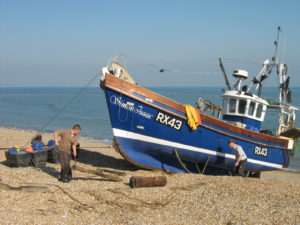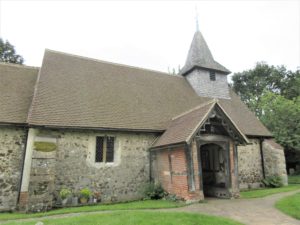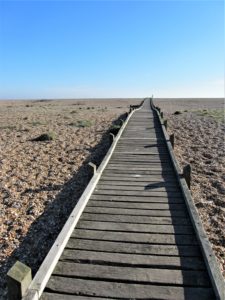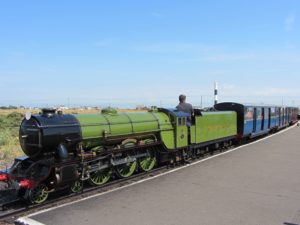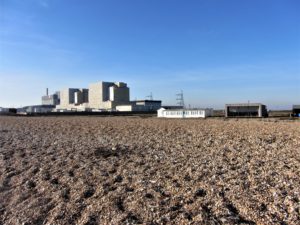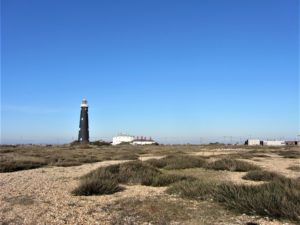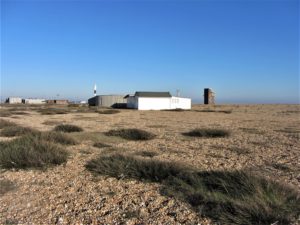Once the lockdown ends the first place I’d like to revisit is Dungeness, an hour’s drive away. It has received a lot of publicity recently due to the purchase of Prospect Cottage, owned by the late Derek Jarman, film maker and artist. But to me Dungeness is just a place I’ve visited once or twice a year throughout my life – a desolate landscape, somewhere to wander across the shingle past the nuclear power stations and two lighthouses, to look at the sea, get blown about by the wind or frazzled by the sun, look at the plants in flower, the birds and butterflies, have fish and chips and then drive home across the marshes.
In the 18th and 19th centuries this area was sparsely inhabited by fishermen and their families: it’s an isolated spot so was used over centuries for smuggling goods in and out of the area. There have also been military garrisons, a redoubt and batteries. However, after the 1st World War many poor people bought disused railway carriages from the Southern Railway Company and set up home in them, over time improving them and adding extensions. Dungeness is a private estate which was bought in 2015 by EDF Energy, who run Dungeness B nuclear power station. Prior to 1999 properties only had 3 month leases but when 99 year leases were made available wealthy people from outside the area bought quirky properties – old fishermen’s winch-houses, railway carriage properties, a coastguard lookout tower – for weekend bolt-holes for themselves and as holiday lets, some now turned into black modernist structures with large sea facing windows.
A National Nature Reserve stretches across Dungeness and encompasses the large RSPB reserve: sticking out into the English Channel as it does Dungeness is a prime place to see migratory birds. Dungeness has been called Britain’s only desert, but I’m not sure how that’s been arrived at; it’s certainly dry but is home to 600 species of plants, my favourites are crambe maritima (sea kale), yellow horned poppies, bluey purple viper’s bugloss and red and white valerian. The ness – over 2,000 hectares of flint shingle – is an unusual triangular shape, formed by longshore drift moving sediment in opposing directions, constantly growing and moving as more pebbles are deposited.
Dungeness can be reached by road from the west through Rye, or from Ashford, or through the winding lanes across the Romney Marsh or along the coastal road from Hythe. An alternative method of transport from Hythe, Dymchurch or New Romney is the Romney, Hythe and Dymchurch railway which is a small gauge railway over 13 miles in length which was begun in 1925. It’s much loved by railway enthusiasts and day trippers but was originally constructed as a regular railway service for locals (my late father-in-law, who lived at Lade adjacent to Dungeness as a boy, used it to get to school in New Romney in the late 1920`s).
There is a cafe and a gift shop at the Dungeness RHDR terminus and the nearby old lighthouse is open at various times so one can climb to the top for panoramic views of the surrounding area. There are two pubs – one is The Pilot, which is at the north-eastern edge of the Dungeness estate, close to the lifeboat station, and the other is The Britannia, which is nearer to the railway station. The Pilot always seems busier but that is probably because the building is older, has more character and is closer to the sea; at weekends it is definitely worth booking if you want to eat there. However, we tend to go to The Britannia as our visits are generally `spur of the moment` and we’ve never been disappointed with the food. The only toilets are those in the pubs, at the station and at the RSPB reserve, although there is a public toilet with adjacent parking on the seaward side of the Lydd-on-Sea road. In the last couple of years a fish shack has also opened, selling fresh fish and cooking fish snacks to order; it is on the left of the road near some fishing huts and appears to be very popular. In normal times the RNLI lifeboat station and shop is open to the public (there is a website). Another must for me is a look in the art studio/gallery as there are always wonderful photographs and other works of art for sale, along with handmade jewellery and driftwood and shell framed mirrors.
Walking across the shingle is hard work but a boardwalk has been built, mainly to protect the beach from too many walkers, and this takes you to the ridge above the shelving beach from where you can look down and usually see people with rods and lines sea fishing and, if lucky, a fishing boat being pulled out of the water surrounded by gulls (all the fishing boats here are launched from the beach). Dungeness is not really a beach for swimming as the currents are dangerous and the beach shelves steeply, but it’s a good place to search for driftwood and shells to make ones own works of art. Disused tanning coppers, winches, winch-houses and other fishing paraphernalia provide fascinating subjects for artists and photographers. The photographs I’ve used were taken over three visits, at different times of the year.
